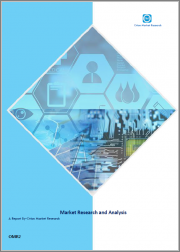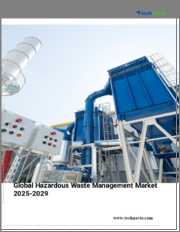
|
시장보고서
상품코드
1350981
세계의 유기 폐기물 처리 시스템 시장(2023-2030년)Global Organic Waste Treatment System Market 2023-2030 |
||||||
세계 유기 폐기물 처리 시스템 시장은 예측 기간 동안 9.0%의 상당한 연평균 복합 성장률(CAGR)로 성장할 것으로 예상됩니다. 유기 폐기물 처리 시스템 연료 세계 시장은 지속 가능하고 재생 가능한 에너지원에 대한 수요가 증가하면서 괄목할 만한 성장을 보이고 있습니다. 또한, 세계 폐기물 발생량이 증가함에 따라 폐기물을 가치 있는 제품으로 전환할 수 있는 폐기물 관리 솔루션에 대한 수요가 급증하고 있습니다. 세계은행 그룹에 따르면, 세계적으로 연간 20억 1,000만 톤의 도시 고형 폐기물이 발생하고 있으며, 이 중 최소 33%는 환경적으로 안전한 방식으로 관리되지 않고 있습니다. 또한 2050년까지 세계 폐기물은 34억 톤으로 증가할 것으로 예상됩니다. 이러한 심각한 통계는 증가하는 폐기물 문제를 해결하고 더 깨끗하고 지속 가능한 미래에 기여할 수 있는 효과적인 폐기물 처리 기술의 도입이 시급하다는 것을 강조합니다.
부문별 전망
매립지 하위 부문이 세계 유기 폐기물 처리 시스템 시장에서 압도적인 점유율을 차지할 것으로 예상
용도별로는 매립지 하위 부문이 예측 기간 동안 큰 성장을 기록할 것으로 예상됩니다. 매립지로부터의 유기 폐기물의 전환 증가, 메탄가스 감축에 대한 인식 증가, 기후 변화 등이 시장 성장을 뒷받침하는 요인으로 작용하고 있습니다. 예를 들어, 2022년 11월 유엔은 기후 온난화 가스 배출을 감지하는 첨단 위성 기반 세계 메탄 감지 시스템인 메탄 경고 및 대응 시스템(MARS)을 발표했으며, MARS는 UNEP 국제 메탄 배출 관측소(IMEO) 전략의 일환으로 설립되었습니다. 데이터-행동 플랫폼으로, 배출량 감축을 위한 정책 관련 데이터를 적절한 곳에 전달하는 것을 목표로 하고 있습니다.
지역별 전망
세계 유기 폐기물 처리 시스템 시장은 북미(미국, 캐나다), 유럽(이탈리아, 스페인, 독일, 프랑스, 기타), 아시아태평양(인도, 중국, 일본, 한국, 기타), 기타 지역(중동 및 아프리카, 라틴아메리카) 등 지역별로 세분화되어 있습니다. 이 중 아시아태평양은 유기 폐기물 처리 시스템 시장에서 큰 성장을 보일 것으로 예상되며, 이는 증가하는 폐기물 발생을 효율적이고 지속적으로 관리하기 위한 수요 증가에 기인합니다.
북미가 유기 폐기물 처리 시스템 세계 시장에서 큰 점유율을 차지할 것으로 예상
북미 유기 폐기물 처리 시스템 시장은 지속 가능하고 재생 가능한 에너지원에 대한 수요 증가로 인해 큰 성장세를 보이고 있습니다. 또한, 이 지역의 폐기물 발생량이 증가함에 따라 폐기물을 가치 있는 제품으로 전환할 수 있는 효과적인 폐기물 관리 솔루션에 대한 요구가 증가하고 있습니다. 폐기물 감소를 촉진하기 위한 정부의 투자 증가는 유기 폐기물 처리 시스템에 대한 수요를 더욱 촉진할 것으로 예상됩니다. 예를 들어, 2023년 2월 미국 농무부(USDA)는 음식물 쓰레기를 줄이고 매립지를 전환하기 위한 혁신적이고 확장 가능한 폐기물 관리 계획을 지원하기 위해 45개 협력 계약에 약 940만 달러를 투자할 예정입니다. 퇴비 및 음식물쓰레기 감소(CFWR) 협력 협정은 미국 구조계획법(American Rescue Plan Act)에 의해 지원되며, 도시농업 및 혁신생산국(OUAIP)을 통한 도시농업에 대한 USDA의 광범위한 지원의 일환입니다.
또한, 이러한 퇴비 및 음식물 쓰레기 감소 프로젝트는 농부와 지역 사회에 혜택을 주는 강력한 음식물 회수 네트워크와 음식물 쓰레기 감소 솔루션 등 탄력적이고 지역적인 식품 시스템을 구축하는 데 중요한 역할을 하고 있습니다.
목차
제1장 보고서 개요
- 업계 현황 분석과 성장 가능성 전망
- 조사 방법과 툴
- 시장 내역
- 부문별
- 지역별
제2장 시장 개요와 인사이트
- 조사 범위
- 애널리스트 인사이트와 현재 시장 동향
- 주요 조사 결과
- 추천 사항
- 결론
제3장 경쟁 구도
- 주요 기업 분석
- Emerson Electric Co.
- 개요
- 재무 분석
- SWOT 분석
- 최근 동향
- Eco Guardians Pty. Ltd.
- 기업 개요
- 재무 분석
- SWOT 분석
- 최근 동향
- Mishimax Co. Ltd.
- 개요
- 재무 분석
- SWOT 분석
- 최근 동향
- TOGO
- 개요
- 재무 분석
- SWOT 분석
- 최근 동향
- 주요 전략 분석
제4장 시장 세분화
- 유기 폐기물 처리 시스템 세계 시장 : 제품 유형별
- 90% 미만
- 90% 이상 95% 미만
- 95% 이상
- 유기 폐기물 처리 시스템 세계 시장 : 용도별
- 슈퍼마켓
- 레스토랑
- 재활용 스테이션
- 매립지
- 기타
제5장 지역 분석
- 북미
- 미국
- 캐나다
- 유럽
- 영국
- 독일
- 이탈리아
- 스페인
- 프랑스
- 기타 유럽
- 아시아태평양
- 중국
- 인도
- 일본
- 한국
- 기타 아시아태평양
- 세계 기타 지역
제6장 기업 개요
- Doda USA
- Ecoverse Industries Ltd.
- ENIC Co., Ltd.
- Gemidan Ecogi A/S
- Haarslev Industries A/S
- HUGG
- Hungry Giant solutions
- Machinex Industries Inc.
- MEIKO Maschinenbau GmbH & Co. KG
- Orca Logo
- Ridan Composting Ltd
- Scott Equipment Company
- The Waste Transformers
- Veolia Environment SA
Title: Global Organic Waste Treatment System Market Size, Share & Trends Analysis Report by Product Type (Below 90%, 90% to 95%, and Above 95%), and by Application (Supermarket, Restaurant, Recycle Station, Landfill, and Others),Forecast Period (2023-2030).
The global organic waste treatment system market is anticipated to grow at a considerable CAGR of 9.0% during the forecast period. The global market for organic waste treatment system fuel is experiencing significant growth owing to the rising demand for sustainable and renewable energy sources. Additionally, the increasing global waste generation has created a pressing need for waste management solutions capable of converting waste into valuable products. According to the World Bank Group, the world generates a staggering 2.01 billion tones of municipal solid waste annually, with at least 33% of that not being managed in an environmentally safe manner. Moreover, global waste is expected to escalate to 3.40 billion tones by the year 2050. These alarming statistics highlight the urgency to adopt effective waste treatment technologies that can address the mounting waste challenge and contribute to a cleaner and more sustainable future.
Segmental Outlook
The global organic waste treatment system market is segmented based on product type and application. Based on the product type, the market is segmented into Below 90%, 90% to 95% and Above 95%. Based on the application, the market is categorized into supermarket, restaurant, recycle station, landfill and others. Among the product type, above 95% is anticipated to hold a prominent market share. The growth of the market is attributed to the development of more efficient technologies to deliver precise and efficient results.
Landfill Sub-Segment is Anticipated to Hold a Prominent Share in the Global Organic Waste Treatment System Market
Among the application, the landfill sub-segment is anticipated to register significant growth for the forecast period. The increasing diversion of organic waste from landfills, rising awareness for methane mitigation, and climate change are some factors supporting the market growth. For instance, in November 2022, the UN announced the methane alert and response system (MARS), which is a high-tech, satellite-based global methane detection system to detect emissions of the climate-warming gas. The MARS is a data-to-action platform set up as part of the UNEP International Methane Emissions Observatory (IMEO) strategy to get policy-relevant data into the right hands for emissions mitigation.
Regional Outlook
The global organic waste treatment system market is further segmented based on geography including North America (the US, and Canada), Europe (Italy, Spain, Germany, France, and Others), Asia-Pacific (India, China, Japan, South Korea, and Others), and the Rest of the World (the Middle East &Africa, and Latin America). Among these, the Asia-Pacific region is projected to experience considerable growth in the organic waste treatment system market, which is attributed to the growing demand to efficiently manage the increased waste generation efficiently and sustainably.
The North American Region is anticipated to Hold a Significant Share in the Global Organic Waste Treatment System Market
The North American market for organic waste treatment systems is experiencing significant growth due to the increasing demand for sustainable and renewable energy sources. Additionally, the region's increasing waste generation has created a greater need for effective waste management solutions capable of converting waste into valuable products. The growing investment from governments, aimed at promoting waste reduction, is expected to further drive the demand for organic waste treatment systems. For instance, in February 2023, the US Department of Agriculture (USDA) invested around $9.4 million in 45 cooperative agreements which will support the innovative, scalable waste management plans to reduce and divert food waste from landfills. The compost and food waste reduction (CFWR) cooperative agreements, which was funded by the American Rescue Plan Act, was part of USDA's broad support for urban agriculture through the Office of urban agriculture and innovative production (OUAIP).
Moreover, these compost and food waste reduction projects play important roles in building resilient, local food systems, including strong food recovery networks and food waste reduction solutions that benefit farmers and communities.
Market Players Outlook
The major companies serving the global organic waste treatment system market include: Emerson Electric Co., Mishimax Co. Ltd., TOGO, Eco Guardians Pty. Ltd., Machinex Industries Inc., MEIKO Maschinenbau GmbH & Co. KG and others. The market players are considerably contributing to the market growth by the adoption of various strategies including mergers and acquisitions, partnerships, collaborations, funding, and new product launches, to stay competitive in the market. For instance, in March 2022, ML Environmental Group and Scott Equipment Company strategically partnered to expand waste recycling solutions for their US clients. Through this partnership, ML Environmental Group's customers can now address a wider range of challenges in organics, construction, demolition waste, and recycling markets. They gain access to additional, complementary system solutions tailored to meet various application requirements.
The Report Covers:
- Market value data analysis of 2022 and forecast to 2030.
- Annualized market revenues ($ million) for each market segment.
- Country-wise analysis of major geographical regions.
- Key companies operating in the global organic waste treatment system market. Based on the availability of data, information related to new product launches, and relevant news is also available in the report.
- Analysis of business strategies by identifying the key market segments positioned for strong growth in the future.
- Analysis of market-entry and market expansion strategies.
- Competitive strategies by identifying 'who-stands-where' in the market.
Table of Contents
1. Report Summary
- Current Industry Analysis and Growth Potential Outlook
- 1.1. Research Methods and Tools
- 1.2. Market Breakdown
- 1.2.1. By Segments
- 1.2.2. By Region
2. Market Overview and Insights
- 2.1. Scope of the Report
- 2.2. Analyst Insight & Current Market Trends
- 2.2.1. Key Findings
- 2.2.2. Recommendations
- 2.2.3. Conclusion
3. Competitive Landscape
- 3.1. Key Company Analysis
- 3.2. Emerson Electric Co.
- 3.2.1. Overview
- 3.2.2. Financial Analysis
- 3.2.3. SWOT Analysis
- 3.2.4. Recent Developments
- 3.3. Eco Guardians Pty. Ltd.
- 3.3.1. Overview
- 3.3.2. Financial Analysis
- 3.3.3. SWOT Analysis
- 3.3.4. Recent Developments
- 3.4. Mishimax Co. Ltd.
- 3.4.1. Overview
- 3.4.2. Financial Analysis
- 3.4.3. SWOT Analysis
- 3.4.4. Recent Developments
- 3.5. TOGO
- 3.5.1. Overview
- 3.5.2. Financial Analysis
- 3.5.3. SWOT Analysis
- 3.5.4. Recent Developments
- 3.6. Key Strategy Analysis
4. Market Segmentation
- 4.1. Global Organic Waste Treatment System Market by Product Type
- 4.1.1. Below 90%
- 4.1.2. 90% to 95%
- 4.1.3. Above 95%
- 4.2. Global Organic Waste Treatment System Market by Application
- 4.2.1. Supermarket
- 4.2.2. Restaurant
- 4.2.3. Recycle Station
- 4.2.4. Landfill
- 4.2.5. Others
5. Regional Analysis
- 5.1. North America
- 5.1.1. United States
- 5.1.2. Canada
- 5.2. Europe
- 5.2.1. UK
- 5.2.2. Germany
- 5.2.3. Italy
- 5.2.4. Spain
- 5.2.5. France
- 5.2.6. Rest of Europe
- 5.3. Asia-Pacific
- 5.3.1. China
- 5.3.2. India
- 5.3.3. Japan
- 5.3.4. South Korea
- 5.3.5. Rest of Asia-Pacific
- 5.4. Rest of the World
6. Company Profiles
- 6.1. Doda USA
- 6.2. Ecoverse Industries Ltd.
- 6.3. ENIC Co., Ltd.
- 6.4. Gemidan Ecogi A/S
- 6.5. Haarslev Industries A/S
- 6.6. HUGG
- 6.7. Hungry Giant solutions
- 6.8. Machinex Industries Inc.
- 6.9. MEIKO Maschinenbau GmbH & Co. KG
- 6.10. Orca Logo
- 6.11. Ridan Composting Ltd
- 6.12. Scott Equipment Company
- 6.13. The Waste Transformers
- 6.14. Veolia Environment SA



















